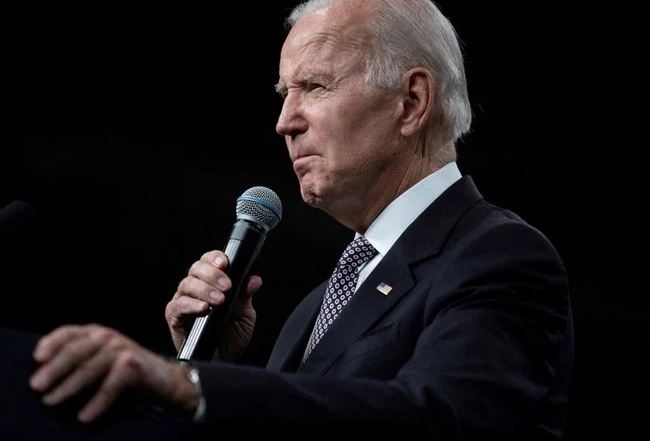President Biden’s Thursday night statement that the world may face “the prospect of Armageddon” if President Vladimir V. Putin uses a tactical nuclear weapon in Ukraine included a revealing aside: Mr. Biden has been trying to help the Russian president find a “off-ramp” that could avert the worst possible outcome.
Mr. Biden made two references to the Cuban Missile Crisis in his remarks at a Democratic fund-raiser in New York, providing a solid indication of what is on his mind. In that infamous instance the closest the world got to a complete nuclear exchange, 60 years ago this month President John F. Kennedy made a secret deal with the Soviet leader, Nikita Khrushchev, to withdraw American missiles from Turkey.
With this bargain, which was not revealed until much later, a catastrophe that might have killed tens of millions of Americans and countless Soviets was prevented.
Mr. Biden’s advisers have been contemplating the possibility of an equivalent agreement, a means for the wounded Russian leader to find an exit, for weeks. They have provided no specifics, understanding that concealment may be the key to a smooth departure and avoiding a situation in which Mr. Putin rushes for nuclear weapons on the battlefield. Friday, White House press secretary Karine Jean-Pierre reaffirmed that President Biden had no fresh information about the deployment of nuclear weapons and that she “saw no indicators” that the Russians were “preparing to use them.”
After Mr. Biden’s statements, several foreign leaders expressed a desire to return to a time when nuclear threats were not publicly acknowledged.
French President Emmanuel Macron said on Friday in Prague, “We must speak with discretion when commenting on such topics.”
As a senior European official said earlier this week, when the history of this age is told, many will be surprised to learn how much effort was being done to analyse the dangers of a nuclear explosion and to consider how to prevent one. Most leaders avoid discussing this matter in public for fear of inciting public panic or market sell-offs.
So it was surprising that the president was the first member of the administration to publicly discuss how to avoid pressing Mr. Putin’s hand at the New York home of James Murdoch, the son of Rupert Murdoch, executive chairman of News Corp., whose holdings include The Wall Street Journal.
Mr. Biden did not respond to his own queries, which mirrored those posed by his advisers. Nor is it evident that Mr. Putin is seeking an exit, at least not yet. At almost every turning point in the battle over the last seven months, he has responded to his forces’ failings by escalating the conflict by calling up untrained recruits, performing more indiscriminate airstrikes on cities, restricting gas flows, and, of course, threatening to deploy his ultimate weapons.
Mr. Putin’s most recent threats were made a week ago, when he said that the United States’ choice to unleash atomic bombs on Hiroshima and Nagasaki in 1945 established a precedent and that he would follow suit if required.
Nonetheless, the primary message that Mr. Biden seemed to be expressing was that he was heeding one of the most important lessons of the Cuban Missile Crisis, which occurred when Mr. Biden was 19 years old. According to him, this lesson is that the United States and its allies must avoid putting Mr. Putin in a position where he is forced to attack.
Mr. Biden’s explanation of the threats is difficult to convert into a timely approach. No one in the administration want to publicly or privately advise that President Volodymyr Zelensky’s government should refrain from driving Russian forces out of every area of Ukraine and back to the boundaries that existed on February 23, the day before the invasion started.
Some Western diplomats and military officials believe that such a debate may be necessary behind closed doors if the objective is to strike a balance between regaining territory and keeping Mr. Putin from lashing out. William Burns, head of the C.I.A. and former U.S. ambassador to Moscow during Vladimir Putin’s ascent to power, said this week on CBS that the Russian leader may be “quite dangerous and irresponsible” when he feels trapped or “feels his back against the wall.”
Of course, this is precisely the kind of judgement that Mr. Putin is attempting to promote; his ultimate goal, according to American intelligence sources, is to divide Europe on the issue of whether to confront or accommodate Moscow.
He has many more rungs to climb on the escalation ladder: He might undertake drills with his nuclear-ready forces, intensify cyberattacks beyond Ukraine’s borders, and employ chemical weapons against dissidents and other targets, as he has in the past. Then, of course, there is the risk of assaults on energy infrastructure — maybe similar to what occurred last week to the Nord Stream I and II gas pipelines, which were unexpectedly shut down.
However, the administration claims it is searching for de-escalation incentives for Mr. Putin, a quest that looks risky.
One of Mr. Putin’s recurring requests is that NATO withdraw its soldiers from former Soviet nations and refrain from what he considers provocative drills on its borders. In the beginning of this year, Putin asked that NATO adopt a pact that would have reverted the alliance to its form in the late 1990s.
Concerned about Mr. Putin’s upcoming territorial ambitions, a number of Eastern European leaders have shown a greater desire than ever before for NATO membership in their respective nations. For them, this is the moment to strengthen their defences, not retreat. Nonetheless, some Western European officials said they might conceive of temporarily reducing military drills or visible troop reinforcements.
All of these measures would be transitory, but Mr. Putin plainly wants a permanent shift in NATO’s posture. As long as his ground forces are suffering, he is unlikely to quit using the strength of his nuclear weapons, according to numerous officials.

